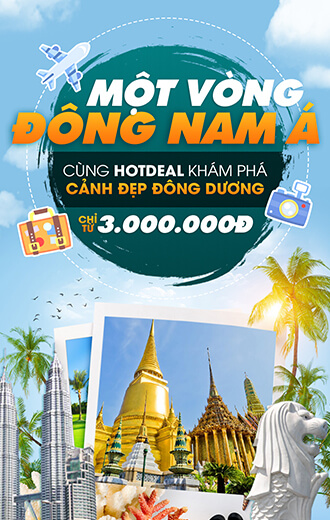Sapa Travel: The Highland Paradise and Cultural Experiences
1. Introduction to Sapa – The Majestic Highland Land
Located in the northwest of Vietnam, Sapa is one of the most attractive tourist destinations in the country. With an average altitude of about 1,500 - 1,800m above sea level, Sapa boasts a cool climate year-round, majestic natural scenery, and unique cultural features of ethnic minorities. Dubbed the “paradise on clouds,” Sapa is where visitors can enjoy the pristine beauty of mountains and forests, explore ethnic culture, and experience many exciting activities.
2. Must-Visit Attractions in Sapa
2.1. Fansipan Peak – The Roof of Indochina
Fansipan, standing at 3,143m, is the highest peak in Indochina and a must-visit destination in Sapa. Nowadays, visitors can conquer Fansipan via a modern cable car or challenge themselves with a mountain climb. From the summit, you can admire the magnificent Hoang Lien Son mountain range and a vast sea of clouds.
2.2. Sapa Stone Church – A Unique Architectural Symbol
Located in the town center, the Sapa Stone Church was built during the French colonial period, showcasing Gothic architecture. It is a venue for many cultural activities of ethnic minorities, especially the Sapa love market every Saturday night.

2.3. Cat Cat Village – A Traditional Ethnic Hamlet
Cat Cat Village is home to the H’Mong people, featuring traditional wooden houses and lush terraced fields. Here, visitors can explore ethnic culture and participate in activities such as weaving, indigo dyeing, and enjoying local cuisine.
2.4. Muong Hoa Valley – A Natural Masterpiece
Muong Hoa Valley stands out with its winding terraced fields and a clear stream flowing through many villages. Particularly, the valley is home to an ancient rock field with mysterious inscriptions, believed to be a heritage left by ancient people.
2.5. O Quy Ho Pass – One of the Four Great Passes of Vietnam
O Quy Ho Pass is one of Vietnam’s most stunning mountain passes. Stretching nearly 50km, it is an ideal spot for cloud hunting and admiring the breathtaking mountain scenery.
3. Unique Cultural Experiences in Sapa

3.1. Sapa Markets – A Cultural Exchange Hub
The highland markets in Sapa are not only places for buying and selling goods but also a hub for ethnic cultural exchanges. Bac Ha Market, Coc Ly Market, and Sapa Market are fascinating destinations where visitors can learn about customs, buy brocade products, and taste local specialties.
3.2. Sapa Love Market – A Unique Cultural Tradition
The Sapa Love Market is a unique cultural feature of the Dao Do and H’Mong ethnic groups. It is not only a place for social gatherings but also where young men and women find their soulmates through traditional dances and songs.
3.3. Savoring Local Cuisine

Sapa’s cuisine is diverse, offering unique highland flavors. Some must-try dishes include:
-
Thang Co – A traditional dish of the H’Mong people with a distinctive taste.
-
Sapa salmon and sturgeon – Farmed in natural cold water, offering firm and sweet meat.
-
Cap Nach pork – A rustic yet delicious dish, often grilled or steamed.
-
Com Lam (Bamboo Rice) – A staple of the northwest, cooked in bamboo tubes for a distinct aroma.
-
Tao Meo Wine – A famous specialty, perfect for warming up in the cold weather.
3.4. Homestay Experience with Locals
Staying in a homestay within a village is the best way to understand the lifestyle and culture of the local people. Visitors can cook, weave fabrics, plant rice, and experience the simplicity and warmth of rural life.
4. Best Time to Visit Sapa
Sapa is beautiful all year round, with each season offering a unique charm:
-
Spring (February - April): Cherry blossoms and plum flowers bloom vibrantly.
-
Summer (May - August): Ideal for viewing lush green terraced fields.
-
Autumn (September - November): Golden ripe rice fields create picturesque landscapes.
-
Winter (December - January): A chance to see snow and enjoy the crisp mountain air.
5. Suggested Itinerary for Sapa Travel

3-Day 2-Night Itinerary:
-
Day 1: Arrive in Sapa, visit the Stone Church, explore Sapa night market.
-
Day 2: Conquer Fansipan, explore Cat Cat Village, visit Muong Hoa Valley.
-
Day 3: Check-in at O Quy Ho Pass, explore the highland markets, and enjoy local cuisine.
6. Travel Tips for Sapa
-
Transportation: You can reach Sapa by bus, train, or motorbike.
-
Accommodation: A wide range of options, from hotels and homestays to luxury resorts.
-
Clothing: Bring warm clothes in winter and comfortable shoes for trekking.
-
Budget: A reasonable expense for a 3-day 2-night trip ranges from 1,500,000 - 4,000,000 VND per person.
Sapa is not only a breathtaking destination with majestic natural landscapes but also a place that preserves the unique cultural values of ethnic minorities. A trip to Sapa will not only bring unforgettable moments but also help visitors gain a deeper understanding of the customs, traditions, and way of life of the local people. If you are looking for a place to explore and relax, plan your trip now to Sapa – this beautiful highland paradise!


 English
English
 Vietnamese
Vietnamese
 China
China
 Korea
Korea
 France
France
 Germany
Germany








